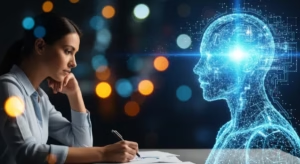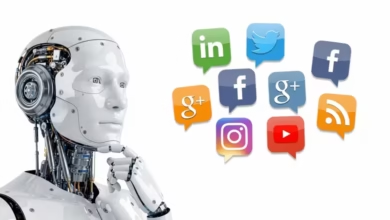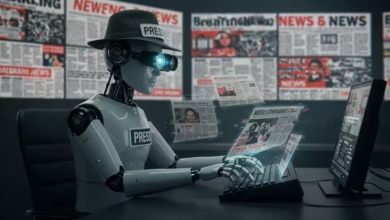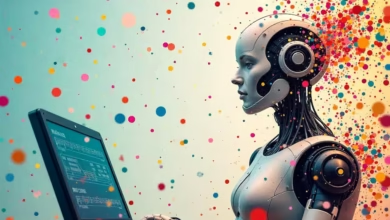AI and the Future of Human Creativity

The blog post titled ‘AI and the Future of Human Creativity’ explores the evolving relationship between artificial intelligence and human creativity. It delves into the intersection of AI and human creativity, highlighting how technology is shaping artistic expression. The article contrasts human and AI-generated art, emphasizing both the unique qualities of human creativity and the efficiencies offered by AI tools. It encourages artists to embrace creative AI tools as a means to enhance their artistic practice. Lastly, the post advocates for integrating AI into the creative process, suggesting actionable steps for artists to incorporate AI into their work. Throughout, the focus remains on how artificial intelligence and human creativity can coexist and enrich the creative landscape.
Exploring The Intersection Of AI And Human Creativity

The fusion of artificial intelligence and art has sparked a revolutionary dialogue in the realm of creativity. AI creativity, a term that embodies the capabilities of machines to generate art, music, and literature, raises fascinating questions about the nature of human creativity. Will we begin to see AI as a collaborator rather than just a tool? As machine learning models continue to evolve, they not only mimic human artistic expression but can also introduce novel aesthetics and styles, challenging our traditional notions of creativity. This evolution invites us to reconsider the role of the artist, artistically complex outputs, and how they shape our cultural landscape.
Key Aspects To Consider
- The evolving definition of creativity in light of AI advancements.
- The potential for AI to enhance human creative processes.
- Ethical considerations surrounding AI-generated content.
- The impact of AI on artistic ownership and copyright.
- Collaborative possibilities between humans and machines.
- Challenges in interpreting AI-generated art.
- The future of creative education with AI inclusion.
As we dive deeper into the interaction of artificial intelligence and human creativity, it becomes evident that this relationship is not simply one of competition. Instead, it offers a unique opportunity for artistic exploration and innovation. AI can serve as a powerful assistant, providing inspiration, refining ideas, and generating unique outputs while allowing artists to focus on the more nuanced aspects of their work. This synergy could redefine how we perceive creativity, blurring the lines between human and machine contributions in the artistic realm.
Diving Deep Into Human Vs AI Art

The debate surrounding human vs AI art has become increasingly relevant as technology evolves. Artists and technologists are exploring the new avenues that artificial intelligence introduces, often leading to discussions about creativity’s nature. While AI can generate incredible pieces that captivate audiences, the essence of human creativity hinges on emotions, experiences, and cultural context, which remains a vital distinguishing factor. Understanding these nuances can help us appreciate both forms of artistic expression.
One of the key differences between human and machine-generated creativity lies in the materialization of emotions. Human artists infuse their work with personal experiences—joy, sorrow, love, and despair. These elements bring depth and resonance to the pieces created. In contrast, AI systems process vast amounts of data to produce artwork without any personal emotional engagement. As we analyze the intersection between these two forms of artistry, we can evaluate how emotion drives the human creative process, making it an irreplaceable component.
Comparative Insights on Human and AI Art
| Aspect | Human Art | AI Art |
|---|---|---|
| Emotional Depth | High | Low |
| Creative Origin | Personal Experience | Data Processing |
| Innovation | Unique | Replication |
The dynamic nature of machine-generated creativity also introduces different technical approaches to creating art. For instance, AI algorithms analyze existing artworks to generate or evolve distinct styles and compositions. This procedural creativity can produce work that may mimic human artistry, yet the thought process is algorithmic rather than intuitive. Understanding these technical nuances is crucial for distinguishing between the organic flow of human creativity and the systematic patterns set by AI.
Five Distinct Differences Between Human And AI Creations
- Emotional Connection: Human art conveys personal feelings, while AI art lacks emotional grounding.
- Authenticity: Human creations are unique expressions, whereas AI often produces variations based on existing data.
- Creative Intent: Human artists have a deliberate message or purpose, while AI’s output is driven by learned patterns.
- Aesthetic Preference: Humans have subjective tastes shaped by culture and experience, unlike AI’s binary choices.
- Evolution of Style: Artists evolve their styles over time based on personal growth, a concept foreign to AI.
The Role Of Emotion In Art
Emotion is a distinguishing factor that colors the human experience of art. Artists draw inspiration from their lived experiences, creating works that resonate with others who may share similar emotions or struggles. This connection fosters a sense of community and shared understanding, making the human creative process deeply impactful. AI can analyze what has historically resonated with audiences but cannot replicate the essence of emotional storytelling found in human artistry.
Technical Differences In Creation
The methodologies employed by artists also vary widely between humans and machines. Human artists may experiment with various mediums, styles, and techniques, leading to unpredictable and innovative outcomes. In contrast, AI relies on algorithms and parameters defined by programmers. While it can produce high-quality art rapidly, this rapid production follows learned patterns rather than the spontaneous breakthroughs seen in human creativity.
Embracing Creative AI Tools For Artistic Expression

As the landscape of artistic expression continues to evolve, embracing creative AI tools has become pivotal for artists and creators seeking to enhance their work. These tools leverage advancements in artificial intelligence and human creativity, allowing artists to explore uncharted territories and reimagine the possibilities of their craft. Many creators are discovering that instead of diminishing their roles, AI can act as a collaborator that expands their creative horizons.
To streamline the integration of AI into the artistic process, it’s essential to adopt effective practices that ensure a harmonious relationship between technology and creativity. Artists can benefit from various AI-driven applications ranging from design and illustration to music composition. By utilizing these tools effectively, creators can enhance their skills, push boundaries, and even overcome creative blocks that may hinder their traditional artistic processes.
| AI Tool | Type of Creative Work | Key Features |
|---|---|---|
| Adobe Sensei | Graphic Design | Automated editing, intelligent tagging |
| DeepArt | Image Transformation | Style transfer, artistic filters |
| AIVA | Music Composition | Generative music, customizable styles |
| RunwayML | Video Editing | Real-time collaboration, advanced visual effects |
Incorporating creative AI tools into artistic work can be a game-changer, but understanding how to leverage these tools effectively is critical. By following established guidelines, artists can create a productive synergy with AI, leading to innovative and inspiring works. Below are some best practices for using AI in art.
Best Practices For Using AI In Art
When working with AI, it is essential to approach it with an open mind and a clear intention. Artists should start by defining their creative goals and determining how AI can assist in achieving those objectives. Additionally, maintaining a balance between traditional techniques and AI applications allows for a richer artistic output. Cultivating a mindset of experimentation can also lead to unexpected and delightful results that are uniquely artistic.
Popular Creative AI Tools
- Adobe Sensei
- DeepArt
- AIVA
- RunwayML
- Artbreeder
- NightCafe Studio
- Daz 3D
By adopting these practices and utilizing innovative tools, artists can harmoniously integrate artificial intelligence and human creativity, paving the way for a new era of artistic expression. This collaboration not only enhances the creative process but also invites a broader audience to engage with and appreciate the artwork produced in this exciting landscape. As we explore the endless possibilities of AI, the future of art continues to look bright and full of potential.
Taking Action: Integrating AI Into Your Creative Process

Integrating Artificial Intelligence and Human Creativity requires a thoughtful approach that explores the synergy between technology and artistic expression. By leveraging AI creativity, artists can unlock new possibilities that refine their work and broaden their imaginative scope. Embracing AI necessitates understanding its capabilities and establishing a collaborative relationship that enhances rather than replaces human input. This integration allows artists to push boundaries while still maintaining their unique voice.
Steps To Effectively Use AI In Your Art
- Identify your creative goals and areas where AI can assist.
- Research and choose the right AI tools that align with your artistic style.
- Experiment with AI-generated content to inspire new ideas.
- Incorporate feedback loops, adjusting your work based on AI outputs.
- Collaborate with fellow artists to explore shared AI tools.
- Document your process to analyze the impact of AI on your creative journey.
- Continuously adapt and refine your techniques as AI technology evolves.
By following these steps, artists can seamlessly incorporate AI into their creative process. As they embrace this technology, it is essential to remember that the goal is not to replace the human touch but to enhance it. AI serves as a powerful ally in the creative journey, offering inspiration and facilitating processes that can lead to groundbreaking art. Thus, through careful integration of AI creativity, artists can redefine their creative boundaries while celebrating their individual artistry.
Briefing Document: AI and the Future of Human Creativity
This fact sheet summarizes key themes and key facts about the intersection of Artificial Intelligence (AI) and human creativity. The resource highlights a collaborative future where AI enhances, rather than replaces, human artistic expression.
Main Themes:
- Evolving Relationship and Collaboration: The core theme is the shifting dynamic between AI and human creativity, moving from a perceived competition to a potential collaboration. The source posits that AI can act as a powerful assistant, refining ideas, generating unique outputs, and allowing artists to focus on nuanced aspects of their work.
- “The fusion of artificial intelligence and art has sparked a revolutionary dialogue in the realm of creativity.”
- “Will we begin to see AI as a collaborator rather than just a tool?”
- “Instead, it offers a unique opportunity for artistic exploration and innovation.”
- Distinction Between Human and AI Art: While acknowledging AI’s ability to generate impressive art, the document strongly highlights the fundamental differences between human and AI creations, particularly concerning emotional depth and creative intent.
- “While AI can generate incredible pieces that captivate audiences, the essence of human creativity hinges on emotions, experiences, and cultural context, which remains a vital distinguishing factor.”
- “Human artists infuse their work with personal experiences—joy, sorrow, love, and despair. These elements bring depth and resonance to the pieces created. In contrast, AI systems process vast amounts of data to produce artwork without any personal emotional engagement.”
- Embracing AI as a Tool for Enhancement: The source actively encourages artists to adopt and integrate AI tools into their creative processes. It views AI not as a threat but as a means to explore new territories, overcome creative blocks, and expand artistic horizons.
- “Embracing creative AI tools has become pivotal for artists and creators seeking to enhance their work.”
- “Many creators are discovering that instead of diminishing their roles, AI can act as a collaborator that expands their creative horizons.”
- Practical Integration of AI: The document provides actionable steps and best practices for artists to effectively incorporate AI into their workflow, emphasizing a thoughtful and goal-oriented approach.
- “Integrating Artificial Intelligence and Human Creativity requires a thoughtful approach that explores the synergy between technology and artistic expression.”
- “By following these steps, artists can seamlessly incorporate AI into their creative process. As they embrace this technology, it is essential to remember that the goal is not to replace the human touch but to enhance it.”
Most Important Ideas/Facts:
- AI redefines creativity: AI advancements necessitate a re-evaluation of the definition of creativity itself.
- Emotional Depth is a Human Hallmark: The ability to infuse work with personal emotions (joy, sorrow, love, despair) is identified as the “irreplaceable component” of human creativity, contrasting with AI’s data-driven, emotionless output.
- “Emotion is a distinguishing factor that colors the human experience of art.”
- Five Distinct Differences (Human vs. AI Creations):Emotional Connection: Human art conveys personal feelings; AI art lacks emotional grounding.
- Authenticity: Human creations are unique; AI often produces variations of existing data.
- Creative Intent: Humans have deliberate purpose; AI’s output is driven by learned patterns.
- Aesthetic Preference: Humans have subjective, culturally shaped tastes; AI makes binary choices.
- Evolution of Style: Artists evolve styles based on personal growth; this is foreign to AI.
- Technical Differences: Human artists explore unpredictable outcomes, while AI relies on algorithms and parameters, producing high-quality art rapidly but following learned patterns rather than spontaneous breakthroughs.
- AI as an “Ally”: The document consistently positions AI as an assistant or ally in the creative journey, providing inspiration and facilitating processes.
- “AI serves as a powerful ally in the creative journey, offering inspiration and facilitating processes that can lead to groundbreaking art.”
- Practical Steps for Integration: The source outlines a 7-step process for artists to integrate AI effectively, including identifying goals, choosing tools, experimenting, incorporating feedback, collaborating, documenting, and continuously adapting.
- Popular Creative AI Tools mentioned: Adobe Sensei, DeepArt, AIVA, RunwayML, Artbreeder, NightCafe Studio, Daz 3D.
- Ethical Considerations: The source briefly notes “Ethical considerations surrounding AI-generated content” and “The impact of AI on artistic ownership and copyright” as key aspects to consider, though it does not delve deeply into them.
The document “AI and the Future of Human Creativity” champions a future where AI and human creativity are not in opposition but in synergy. It provides a foundational understanding of the unique qualities of human art, particularly its emotional depth and personal intent, while simultaneously advocating for the practical integration of AI tools to enhance and expand human artistic potential. The overarching message is one of embracing technological evolution to foster a richer and more innovative creative landscape.
For similar articles, please visit: AI in Art, Creativity & Media
Homepage / humanaifuture.com
🎧 Listen to the Podcast
Want to explore this topic in more depth? Listen to the full podcast for more insights and expert commentary.
▶️ Play on Google DriveNo sign-up needed — just click and listen.
What are the key differences between human and AI-generated art?
The primary differences lie in emotional depth, creative origin, and intent. Human art is deeply infused with personal emotions, experiences, and cultural context, making it unique expressions driven by deliberate messages. In contrast, AI art lacks emotional grounding, deriving its output from processing vast amounts of data and learned patterns, making it more of a replication or variation based on existing data rather than an authentic, evolving style.
How can artists effectively embrace and integrate AI tools into their creative process?
Artists can embrace AI tools by viewing them as collaborators that expand creative horizons rather than diminish their roles. Effective integration involves identifying specific creative goals where AI can assist, researching and choosing suitable AI tools, experimenting with AI-generated content for inspiration, incorporating feedback loops, collaborating with other artists, documenting the process, and continuously adapting to evolving AI technology.
What role does emotion play in distinguishing human creativity from AI creativity?
Emotion is a crucial distinguishing factor for human creativity. Human artists draw from lived experiences to imbue their work with personal feelings (joy, sorrow, love, despair), creating depth and resonance that fosters connection and shared understanding. While AI can analyze what has historically resonated with audiences, it cannot replicate the essence of emotional storytelling or personal engagement found in human artistry.
What are some practical steps for artists to incorporate AI into their artwork?
Artists can begin by clearly defining their creative goals and identifying areas where AI can be beneficial. They should then research and select AI tools that align with their artistic style. Experimentation with AI-generated content is encouraged to spark new ideas, and artists should establish feedback loops to refine their work based on AI outputs. Collaborating with peers and documenting their AI-assisted creative journey can further enhance their understanding and adaptation to this technology.
How does the technical approach of AI differ from human creative methodologies?
Human artists often experiment with diverse mediums, styles, and techniques, leading to unpredictable and innovative outcomes driven by intuition and personal growth. Conversely, AI relies on algorithms and parameters defined by programmers, processing vast datasets to produce art. While AI can generate high-quality art rapidly, its production follows systematic patterns and learned behaviors rather than the spontaneous breakthroughs characteristic of human creativity.
What ethical considerations arise with the advancement of AI-generated content?
The rise of AI-generated content brings forth several ethical considerations. These include questions about artistic ownership and copyright, given that AI often produces variations based on existing data. There are also challenges in interpreting AI-generated art, as it lacks the inherent personal intent of human creators. Furthermore, the evolving definition of creativity and the potential for AI to blur the lines between human and machine contributions raise questions about authenticity and the future of creative education.
How does the future of human creativity look with the inclusion of AI?
The future of human creativity with AI inclusion appears bright and full of potential. Instead of competition, the relationship offers unique opportunities for artistic exploration and innovation. AI can serve as a powerful assistant, providing inspiration, refining ideas, and generating unique outputs, allowing artists to focus on more nuanced aspects of their work. This synergy is expected to redefine how we perceive creativity, fostering a new era of artistic expression where human and machine contributions coexist and enrich the creative landscape.




